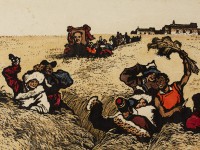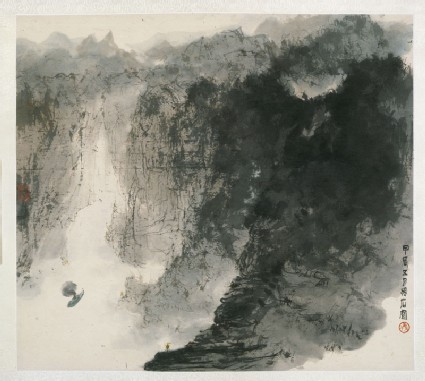Art in China in the 1960s and 1970s
(from 15th Apr 2011 until 15th Jan 2012)Explore woodblock prints and ink paintings from around the period of the Cultural Revolution in China.

River landscape with steamboat
-
Description
Fu Baoshi was born in Nanchang, Jiangxi province. From 1933 to 1935 he studied in Tokyo at the Imperial Art Academy, and on his return taught at the Central University in Nanjing from 1935 to 1952. During the Sino-Japanese War he moved with the University to Sichuan province, and in 1946 he returned to Nanjing where he spent the rest of his life. He sat on artists’ committees at both national and local levels. In 1959 he collaborated with Guan Shanyue on a huge landscape painting ‘This land with so much beauty aglow’ for Beijing’s Great Hall of the People, and is regarded as the one of the greatest literati painters of the 20th century.
This river landscape is in Fu’s typical style, which he developed in the 1930s and to which he remained true throughout his career. He was deeply influenced by the Qing individualist painter Shi Tao, whose biography he wrote. The painting also features steam ships and light towers, signifying a new and modernized nation under socialist construction.
-
Details
- Associated place
-
Asia › China › Jiangsu province › Nanjing (place of creation)
- Date
- 1964
- Artist/maker
-
Fu Baoshi (1904 - 1965) (artist)
- Material and technique
- ink and colour on paper; mounted on layers of paper, framed with ling silk pieces; backed with paper scroll
- Dimensions
-
mount 192 x 74 cm (height x width)
painting 54.5 x 61 cm (height x width)
along roller 83 cm (length)
- Material index
-
organic › animal › animal product › silk,
- Technique index
- Object type index
- No. of items
- 1
- Credit line
- Purchased, 1965.
- Accession no.
- EA1965.254
-
Further reading
Vainker, Shelagh, Chinese Paintings in the Ashmolean Museum, Oxford (Oxford: Ashmolean Museum, 2000), no. 24 on p. 44, illus. p. 44 fig. 24
Past Exhibition
see (1)Location
-
- currently in research collection
Objects are sometimes moved to a different location. Our object location data is usually updated on a monthly basis. Contact the Jameel Study Centre if you are planning to visit the museum to see a particular object on display, or would like to arrange an appointment to see an object in our reserve collections.
Publications online
-

Chinese Paintings in the Ashmolean Museum, Oxford
Fu Baoshi was born in Nanchang, Jiangxi province. From 1933 to 1935 he studied in Tokyo at the Imperial Art Academy, and on his return taught at the Central University in Nanjing where he was professor from 1935 to 1952; during the Sino-Japanese War he moved with the University to Chongqing (Chungking) in Sichuan and in 1946 he returned to Nanjing where he spent the rest of his life. He sat on artists' committees at both national and local levels and in 1959 collaborated with Guan Shanyue (q.v.) on the huge painting 'This land with so much beauty aglow' in the Great Hall of the People at Tiananmen Square, Beijing. Fu wrote widely on the history of painting and in the 1930s developed his own style, to which he remained true throughout his career; he was deeply influenced by the Qing indiviualist painter Shi Tao, of whom he wrote a biography. Together with Huang Binhong (q.v.) he is regarded as the greatest literati painter of the twentieth century. See also Cat.No.31.
Notice
Objects from past exhibitions may have now returned to our stores or a lender. Click into an individual object record to confirm whether or not an object is currently on display. Our object location data is usually updated on a monthly basis, so please contact the Jameel Study Centre if you are planning to visit the museum to see a particular Eastern Art object.
© 2013 University of Oxford - Ashmolean Museum


